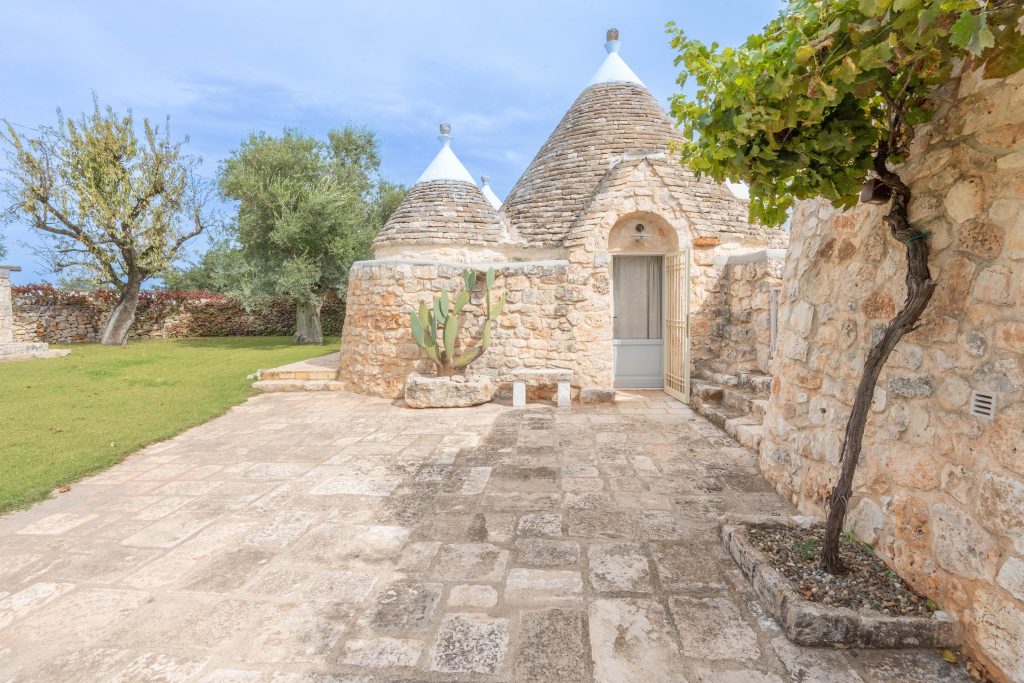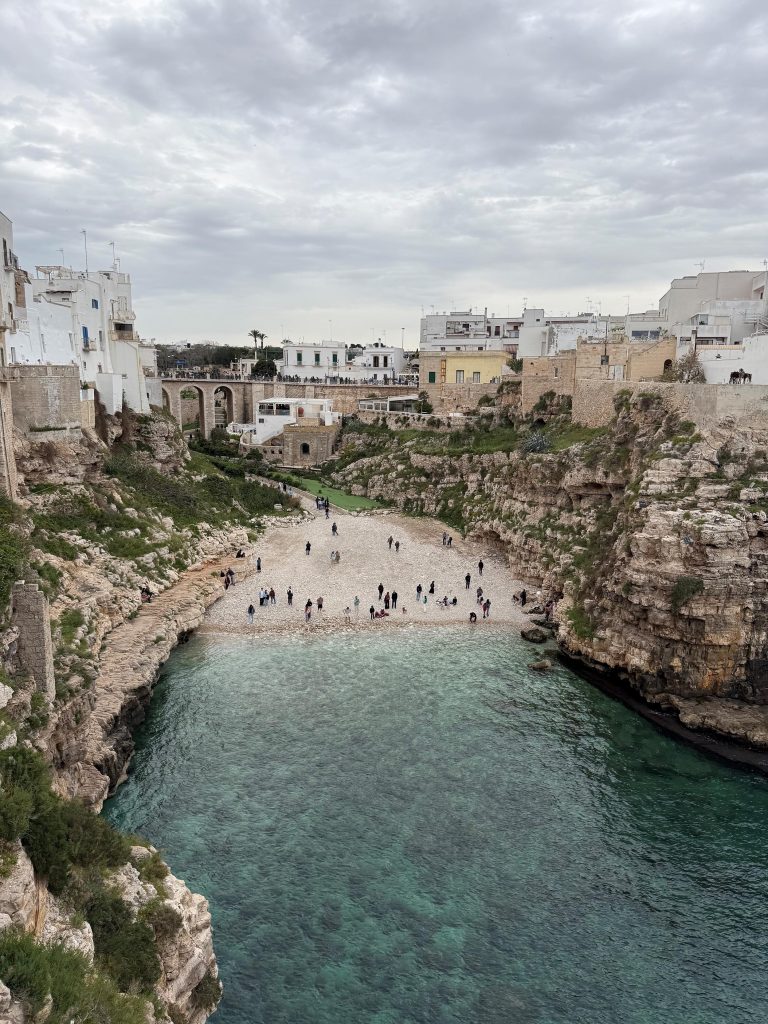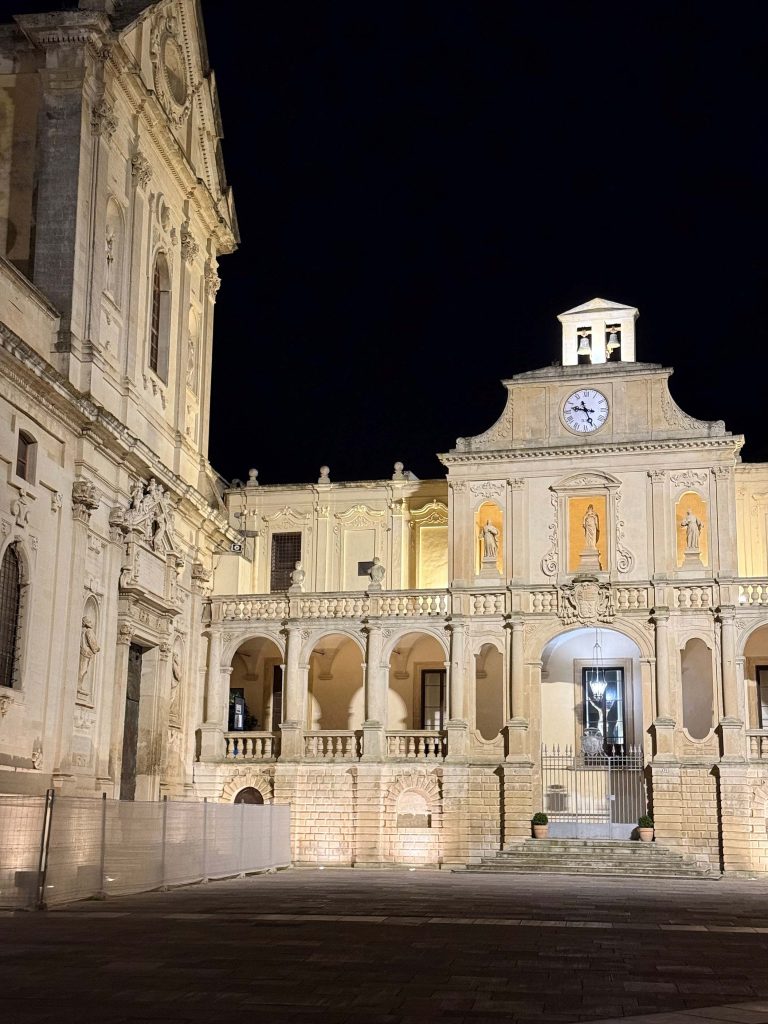In the sun-drenched heel of Italy’s boot lies Puglia, a region that effortlessly blends rustic charm with coastal elegance.
Kait McMurdo October 28, 2025
In the sun-drenched heel of Italy’s boot lies Puglia, a region that effortlessly blends rustic charm with coastal elegance—and one local’s lifestyle paints a vivid picture of its allure. This Spring, I had the pleasure of spending a fleeting 48 hours with Valentina Bodini, broker/owner of Gruppo Bodini in Puglia. A self-proclaimed citizen of the world, Bodini splits her time between Rome, Milan, and Puglia, but it’s the latter that truly captures her heart. On arrival, I was whisked to Bari and treated to several courses of beef dishes, the local specialty in the largest city of Puglia (locally known as Apulia). Following the decadent lunch, we ventured to Alberobello on country roads lined with ancient olive groves and dotted with the whimsical trullis, houses made of stone conical shapes, and masserias, traditional fortified farmhouses.
We spent the evening in the city of Lecce, with its stunning examples of baroque architecture in “Lecce Stone,” a particular type of limestone that renders the city a buttery yellow tone. In the morning, we visited a centuries-old castle that was being remodeled into a luxury boutique hotel. The abundant variety of opportunities to find a place of your own was reflected in the many styles of homes in the region. As Bodini shares, “Puglia offers a truly unique blend of natural beauty, cultural richness, and real estate value that’s hard to find elsewhere in Italy. Whether it’s a trullo in the countryside or a seafront villa, buyers are drawn by the lifestyle and long-term potential.”
With transportation that favors scenic drives and coastal bike rides, visitors can easily explore hidden coves and hilltop towns like Ostuni, Alberobello, and Lecce. The region is a haven for food lovers—think focaccia barese, fresh seafood, and olive oil from trees older than history itself. Puglia invites travelers to slow down, savor, and discover its many secrets. As Benedetto Di Gennaro, one of the Bodini Group’s agents claims, “we’re seeing growing interest from buyers across Europe and North America who want an authentic Italian experience—and Puglia delivers. The region’s strong rental appeal and reasonable property prices make it a smart choice.” Ready to fall in love with Italy’s heel? Puglia is waiting.

Where do you live? It’s hard to give a straight answer to this question because I’m a citizen of the world! 🙂 I split my time between Rome, Milan and Puglia and I’m constantly on the move!
What is the perfect weekend day like? A perfect weekend day in Puglia starts with a slow morning—espresso at a local bar, maybe a fresh pasticciotto (a custard-filled pastry). Then, depending on the season, it’s either a trip to the beach (we’re spoiled for choice with both the Adriatic and Ionian coasts) or a countryside hike among the olive groves and trulli. Lunch is long, shared with family or friends, ideally with orecchiette and local wine. Evenings are for passeggiata in the town square and maybe a gelato.
What are the common modes of transportation there? Most people get around by car, especially in the countryside and smaller towns. In cities like Bari or Lecce, you’ll find public buses and a few trains. The regional trains connect major towns, but if you want to explore off-the-beaten-path places, driving is best. Bikes and scooters are popular too, especially near the coast.
Tell us about the foods your area is known for. Puglia is a food lover’s dream! We’re known for orecchiette pasta (especially with turnip tops or tomato sauce), focaccia barese with cherry tomatoes and olives, and lots of dishes made with fresh vegetables and legumes. Seafood is big here too—octopus, mussels, and anchovies. And don’t forget the olive oil—some of the best in the world!
What is your favourite meal, at home or at a restaurant? My favorite meal has to be homemade orecchiette alle cime di rapa—made fresh by my nonna (grandmother), of course. But when eating out, I love going to a seaside trattoria in Polignano a Mare for grilled octopus and fresh seafood pasta.
Where do you recommend someone vacation in your region and why? It’s hard to pick just one, but I’d recommend Ostuni, the “White City.” It’s a stunning hilltop town with whitewashed buildings, narrow alleys, and a magical atmosphere—especially at sunset. Plus, it’s close to amazing beaches and great food. Alberobello and Lecce are also must-visits for culture and architecture.
What is your favourite recreational or leisure time activity? I love taking long walks along the coastline or hiking in the Valle d’Itria. In the summer, swimming or paddleboarding in the crystal-clear waters is unbeatable. And in the evenings, nothing beats gathering with friends at a local piazza for drinks and conversation.
Is there a specialty your area is known for? Puglia is world-famous for its extra virgin olive oil, made from ancient olive trees, some over a thousand years old. We’re also known for Primitivo and Negroamaro wines, and the iconic trulli houses in Alberobello.
Share a little known but interesting fact about the area/region: Puglia has the longest coastline of any region in mainland Italy—more than 800 kilometers! That means tons of hidden coves, beaches, and fishing villages to discover. It’s also home to one of the oldest olive trees in the world, estimated to be over 3,000 years old.
If you were to live in any other region where we have a Coldwell Banker presence, where would it be and why? If I had to leave Puglia (though it would be hard!), I’d choose Tuscany. It has a similar love for food and tradition, stunning landscapes, and rich history. Florence’s art and architecture are amazing, and the rolling hills remind me a bit of our countryside here..
Territory Summary
Puglia, located in the southeastern “heel” of Italy’s boot, is a region rich in history, culture, and natural beauty. Bordered by the Adriatic Sea to the east and the Ionian Sea to the south, it boasts the longest coastline of any mainland Italian region—over 800 kilometers. Its geography is predominantly flat with gently rolling hills, fertile plains, and iconic olive groves that stretch as far as the eye can see. Towns like Lecce (known as the “Florence of the South”), Alberobello (famous for its UNESCO-listed trulli houses), and Bari (the regional capital) showcase this rich historical legacy. Economically, Puglia has long relied on agriculture as a pillar of its identity. The region is one of Italy’s leading producers of olive oil, wine, wheat, and vegetables, thanks to its Mediterranean climate and fertile soil. In recent decades, tourism has become a major economic driver, with visitors drawn to the region’s charming towns, pristine beaches, and traditional cuisine. There’s also a growing focus on sustainable tourism and agri-tourism, attracting travelers interested in authentic rural experiences. In addition, Puglia is developing its renewable energy sector, especially wind and solar power, and has active ports supporting trade and transportation across the Adriatic. In essence, Puglia is a land where ancient traditions meet modern innovation—a region that balances its rural roots with emerging economic potential.

Key Facts
Population: 4 million people
Language(s) Spoken: Italian (but Puglia also has a rich tapestry of regional dialects, which vary significantly from town to town. In some areas, especially in the Salento peninsula, people speak a dialect known as Salentino or Griko—a rare Greek-influenced dialect still spoken by some older residents.
English is increasingly understood in tourist areas and by younger generations, but in more rural parts, Italian is essential for daily life).
Climate: Mediterranean
Currency: Euro
Industry Facts
Types of Architecture: Puglia features a mix of traditional, rural, and historic architecture, as well as more modern urban housing. Common types include:
Trulli: Iconic cone-roofed stone houses found mainly in the Itria Valley (e.g., Alberobello). Often restored and used as holiday homes.
Masseria: Traditional fortified farmhouses, often renovated into luxury estates or agritourism businesses.
Baroque and historic townhouses: Especially in cities like Lecce and Martina Franca.
Modern apartments and villas: Found in coastal areas and cities like Bari and Brindisi.
Seaside properties: Villas and small apartment complexes near beaches, especially popular for foreign buyers.
Average Sale Price: Property prices in Puglia are generally more affordable than in northern Italy or Tuscany.
City/Urban areas (Bari, Lecce, Brindisi): €1,500 – €2,500 per sq. meter (approx. €140 – €230 per sq. ft)
Countryside/villages (Valle d’Itria, Salento): €800 – €1,800 per sq. meter (approx. €75 – €165 per sq. ft)
Luxury or renovated trulli/masseria properties: €2,500 – €5,000+ per sq. meter (approx. €230 – €465+ per sq. ft), depending on location and amenities
Average years in house/apt: Homeownership is deeply rooted in Italian culture. In Puglia:
People tend to stay in the same home for decades, often inheriting properties.
Many family homes are passed down generations, so the average tenure can be 20–30+ years.
However, foreign buyers (especially from the UK, Germany, France, and the U.S.) purchasing second homes often use them for seasonal stays or short-term rentals.
Types of Financing Available
Italian Mortgages: Offered by Italian banks, usually require 30–40% down payment for foreign buyers
Loan terms: 10–25 years
Fixed and variable rates available (as of 2025, average mortgage rates are around 3.5–4.5%)
Income verification and international credit checks are required
Cash Purchases: Many foreign buyers choose to buy in cash, especially for lower-priced rural homes or renovation projects.
Renovation Incentives: Puglia (south of Italy) is currently offering tax credits and incentives for restoring historic properties (like the PIA Turismo and MINI PIA Turismo).
Facebook: https://www.facebook.com/share/15G39x9sJk/?mibextid=wwXIfr
Instagram: @gruppobodini_immobiliare
LinkedIn: linkedin.com/company/coldwellbanker-gruppobodini/


 Facebook
Facebook
 X
X
 Pinterest
Pinterest
 Copy Link
Copy Link



